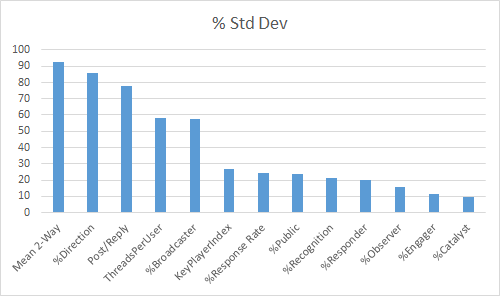How Cohesive is your Community?
SWOOP: Mean 2-Way Connections
Social cohesion is synonymous with ‘community’. Intuitively we experience social cohesion when we participate in high performing communities. Experienced ‘networkers’ lead these communities. New members are made to feel welcome. Community objectives are met through active engagement between members. High performing online communities are a fertile field for knowledge sharing amongst its members. While qualitatively we can experience and differentiate a good community from a poor one, what measures are available to assist leaders in monitoring social cohesion in their communities? How can these measures be used to help grow social cohesion?
This post continues the series of deeper dives into the specific measures included in the SWOOP Collaboration Framework #swoopframework. We have previously addressed individual behavioural personas. The Mean 2-way Connections measure is community wide, and our measure for social cohesion.
How is this Measured?
The Mean 2-Way Connections measure calculates the average number of reciprocated connections each community member has. An example of a reciprocated connection created is if say, you reply to a post by person A and then person A replies to a post of yours. A community rich with members having a high number of two-way connections is going to be a highly cohesive one. On the other hand, a community with a low Mean 2-Way Connections score will have created few sustainable relationships between its members and therefore much less cohesion.
Interpretation
The Mean 2-Way Connections is our measure of social cohesion. For the majority of communities, the higher this score, the better. A high score means that it is highly likely that strong relationships are being developed amongst the membership. We know that strong relationships underpin trust, and with trust we get speed and tangible results, as Stephen Covey elegantly represents in his book ‘The Speed of Trust’. Where we have been able to compare online communities/groups within the same enterprise on this measure, we have found qualitative reinforcement that the more cohesive a community is, the more value that it is creating for its members and the enterprise.
Importantly, the social cohesion measure was the result with the greatest spread from best to worst in our benchmarking studies. The following chart shows the relative spread of results amongst a selected set of 21 enterprises:
In essence this chart indicates the Mean 2-Way Connections (social cohesion) is the measure that most differentiates good from poor performance. It is also therefore the dimension that offers the most potential for improvement.
There is however an upper limit for social cohesion within a community. This point is where a community reaches, what we commonly call ‘group think’. In these circumstances, highly cohesive communities become immune to ideas from outside the community. Innovation stagnates, and while the community may still be successful, it will find it increasingly hard to deliver further improvements, without introducing more diversity within its membership.
What should this mean to you?
As an individual, one should always be looking to maximize the number of reciprocated relationships one has. Having a high number of 2-way relationship connections should result in your being seen as an ‘Engager’, the most productive behavioural persona. Recall that Engagers are able to effectively manage their ‘give-receive’ balance. They become the glue that binds a community.
As a community leader, a high average 2-way relationship score means that your members are actively engaged in community activities and delivering value for the community and its sponsors. On the other hand, a low score indicates poor social cohesion and therefore much work to do. To build up social cohesion in your community, you need to start with identifying a few important tasks that selected groups of members can actively work and collaborate on. Traction is gained around these activities and value stories are shared amongst the broader community. You will see the 2-Way Relationships score grow, as the membership becomes more engaged in its activities.
In summary, social cohesion and its specific measure of Mean 2–Way Connections is seen as, arguably, the clearest measure of a successful community. Social cohesion is synonymous with community. Our benchmarking studies have shown that it is also the measure that most differentiates excellent from poor community performance. For those communities exhibiting poor social cohesion, the task is to develop activities that encourage members to reciprocate. There is however price for too much cohesion; and that is a lack of diversity and innovation, which could lead to eventual stagnation, if not managed properly.


